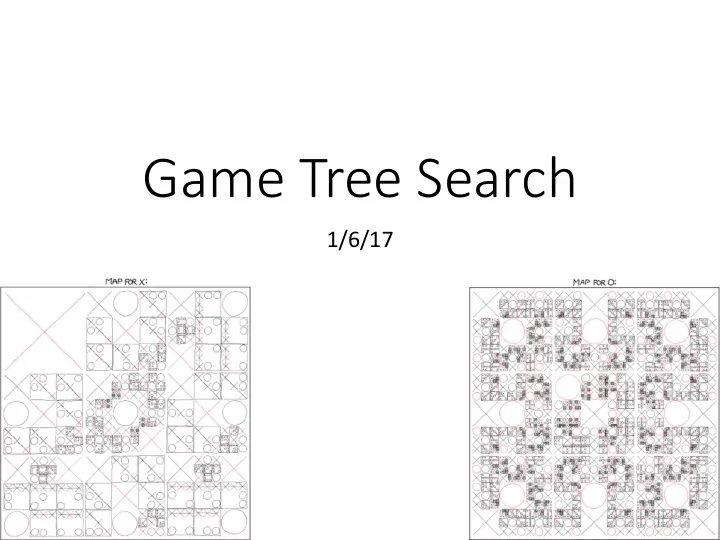

Game Tree Search 1/6/17
Frameworks for Decision-Making 1. Goal-directed planning • Agents want to accomplish some goal. • The agent will use search to devise a plan. 2. Utility maximization • Agents ascribe a utility to various outcomes. • The agent attempts to maximize expected utility.
Advantages of Utility Modeling • Handles uncertainty better • Choose actions to maximize expected utility. • We’ll take advantage of this in a few weeks. • Simplifies modeling other agents • Assume all agents are utility maximizers. • And all agents know all other agents are utility maximizers. • We just have to figure out their utilities. Sometimes this is really hard, but this week it’s easy.
Behaving Optimally with Multiple Agents We need game theory! If agents act sequentially: If agents act simultaneously: • Extensive form games • Normal form games 1 R P S 1 L R R 0,0 -1,1 1,-1 2 2 2 P 1,-1 0,0 -1,1 L R L R S -1,1 1,-1 0,0 3,1 2,1 1,2 0,0 • Our focus this week. • We’ll come back to this at the end of the semester.
Extensive form game terminology decision nodes (states) Each node belongs to a 1 specific agent (player). actions (moves) L R 2 2 R L R L 1,2 0,0 3,1 2,1 terminal nodes (outcomes) Each outcome lists a utility for every player.
Example Game: Nimm • There are initially N pieces. • Each turn a player must remove 1, 2, or 3 pieces. • The player who removes the last piece loses. Let’s play a game where N=9, you go first.
Exercise: play a few games of Nimm • Try different values of N. • 1, 2, 3, …, 9, 10, … • Who wins under optimal play? • How does it depend on N?
N Outcome for P1 First move 1 L 1 2 W 1 3 W 2 4 W 3 5 L ? 6 W 1 7 W 2 8 W 3 9 L ? 10 11 12 13 14
Backward Induction Key idea: start from outcomes and work your way up. • At leaf nodes, return the outcome. • At decision nodes, recursively determine the outcome of each action. • The optimal move is the one that gives the best outcome for the current player.
N = 5 1 1 2 3 2 2 2 3 1 3 1 2 2 1 2 1 1 1 1 W , L 1 1 3 2 2 1 2 1 1 1 L , W 2 2 L , W 2 L , W L , W 1 2 1 1 1 W , L W , L W , L 2 L , W 1 1 1 1 L , W L , W W , L W , L
N = 5 1 1 2 3 2 2 2 3 1 3 1 2 2 1 2 1 1 1 1 W , L 1 1 3 2 2 1 2 1 1 1 L , W 2 2 L , W 2 L , W L , W 1 2 1 1 1 W , L W , L W , L 2 L , W 1 1 1 1 L , W L , W W , L W , L
Backward Induction Pseudocode function backward_induction(state, player): if state is terminal: return outcome initialize best_outcome, best_utility for each action available in state: ns, np = make_move(state, action) outcome = backward_induction(ns, np) if utility(outcome, player) > best_utility: update best_outcome, best_utility return best_outcome
Special Case: Zero-Sum Games • The sum of utilities is zero for every outcome. 1 1 L R L R 2 2 2 2 L R L R L R L R 3,1 -2,1 -1,-2 0,0 3,-3 -2,2 1,-1 0,0 not zero-sum zero-sum • In a zero-sum game, my gain is always your loss. • We can represent one-fewer utility per outcome. • Is Nimm zero-sum?
Min-Max Pseudocode function min_max(state, player): if state is terminal: return none, value initialize best_action, best_value for each action available in state: next_state = make_move(state, action) act, val = min_max(next_state, other_player) if player is maximizer and val > best_value: update best_action, best_value if player is minimizer and val < best_value: update best_action, best_value return best_action, best_value
Alternative Min-Max Pseudocode function max_value(state): if state is terminal: return value initialize best_val for each action available in state: next_state = make_move(state, action) best_val = max ( min_value (next_state), best_val) return best_val function min_value(state): ... best_val = min ( max_value (next_state), best_val) ...
Problem: game tree size • For most interesting games the game tree is too large to search to the end and to find optimal moves. • In chess, the branching factor is approximately 35 and games can last for 100 moves. • This creates a game tree of 35^100 nodes which is approximately 10,154! . • Instead we will search to a limited depth and try to approximate the value of states. How big is the game tree for tic-tac-toe? Checkers?
Evaluation Function • Look at a game state without knowing any context and try to assign it a value. • Performance of a game playing program is highly dependent on this evaluation. • Using a good evaluation function allows us to make informed decisions about which move now is likely to lead to good situations later.
Features of a good evaluation function • When a terminal state is reached, score it correctly. • Should be efficient to calculate since it will be called many, many times. • Should reflect the actual chances of winning. • Exactness is less important than trying to get the relative values correct.
Recommend
More recommend